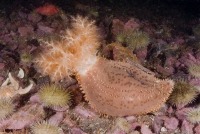
(Photo: Andrew J. Martinez)
Orange-Footed Sea Cucumber
Cucumaria frondosa
An oblong animal similar in shape to a cucumber, with a crown of 10 branched tentacles. They grow to be up to 30 centimetres in length, and 15 centimetres in diameter. Their leathery skin can be brown, green, grey, purple, orange, and sometimes white. Juveniles are as small as one millimetre and coloured translucent orange and pink. They attach to substrates on the seafloor using five rows of orange tube feet that run the length of the body.
Authority
Gunnerus, 1767
Classification Details
Phylum: Echinodermata (echinoderms); Class: Holothuroidea (sea cucumbers).
Habitat
Found on rock and cobble bottoms, from low intertidal to 30 metres. Less often found on sand and mud bottoms, and to a depth of several hundred meters. Sometimes found in dense groupings, forming carpets on the ocean floor. Common throughout the western North Atlantic and Arctic, to Cape Cod. Also found in eastern North Atlantic and Pacific waters.
Diet
Suspension feeders. Their many-branched tentacles are covered with sticky mucous. They extend these to catch particles floating in the water column. They then place one tentacle at a time into their mouth and scrape off the trapped plankton and detritus. They feed only in the summer and spring, when environmental conditions are favourable. They stop eating for the duration of the fall and winter months.
Reproduction
Sexes are separate. Females have tube-shaped gonopores and males have heart-shaped gonopores. Sea cucumbers have only one gonad which opens to the outside to release eggs or sperm into the water for external fertilization. The fertilized embryos develop first into a planktonic larval stage called auricularia. Following the first stage is a barrel-shaped stage called doliolaria. Finally, around 50 days after fertilization, they develop into benthic juvenile sea cucumbers. This species lives for around 10 years.
Fun Facts
They can contract their muscles to spew out some of their internal organs as a defence mechanism. The predator eats these while the cucumber escapes. The organs are later regenerated.
References
Feindel S, Bennett T and Kanwit K (2011) The Maine Sea Cucumber (Cucumaria frondosa) fishery. Department of Maine Natural Resources. Available from https://www.maine.gov/dmr/science-research/species/cukes/index.html Accessed online 20 January 2020. Martinez AJ (2019) Marine life north Atlantic. Digital application http://marinelifeofthenorthatlantic.com/ Accessed online 20 January 2020. National Geographic. Sea Cucumbers – Animals, Photo Ark. https://www.nationalgeographic.com/animals/invertebrates/group/sea-cucumbers/ Accessed online 20 January 2020. Palomares MLD and Pauly D (2019) Sealife Base. Cucumaria frondosa (Gunnerus, 1770) orange-footed sea cucumber. https://www.sealifebase.ca/summary/Cucumaria-frondosa.html Accessed online 20 January 2020.

